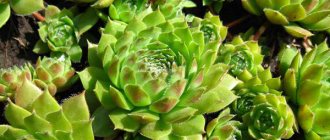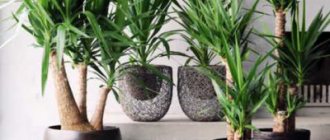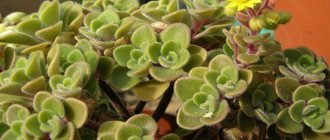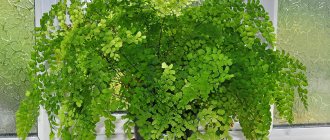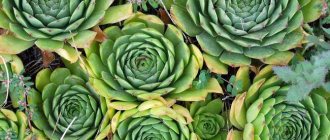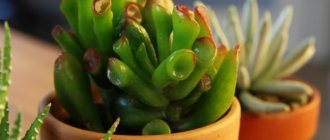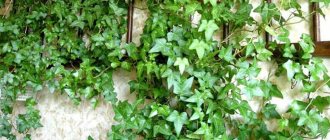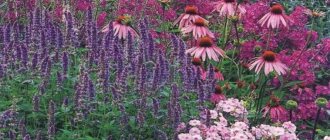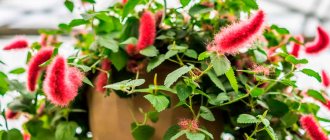Saxifraga, stone rose, hare cabbage, tenacious, crassula, thunderweed - these are all nicknames for one plant! Its main name, rejuvenated , comes from two Latin words that translate as "always alive."
This is an evergreen and beautiful plant. The leaf color is most often green . There are varieties with red leaves or a combined version.
Beliefs about saxifrage
According to one of the legends in Scandinavia, rejuvenation was the plant of the god Thor. It was often planted on the roofs of houses . People believed that this would protect the house from lightning, the ruler of which was Thor. This is where one of the names of the plant came from: rejuvenated roofing sempervivum tectorum .
In Egypt, it was believed that the plant came from the seed of the god Amun. The young man was also credited with masculine strength due to the similarity of its flower to the male organ. And in England they believed that if saxifrage bloomed in the house of an unmarried girl , then she would soon get married.
According to other legends, tincture from the plant improves vision and hearing; girls rubbed its juice for blush. Some believed that if you carry a socket with you, you will not be bitten by a scorpion .
Place in the garden: options available
The young plants are not just beautiful plants, they are distinguished by a very extraordinary “character”, since they open up space for creating unexpected compositions. Most often they are used in rock gardens, on alpine slides and retaining walls: multi-colored rosettes look harmonious among the stones. These well-growing groundcover plants can camouflage and beautify areas with poor soil (for example, left over after building a house). In this case, gravel gardens with succulent plants, which are becoming fashionable, are an excellent opportunity to quickly and effectively transform the area. Well, those who are ready to devote a lot of time and effort to the garden can create “carpets” and fancy borders by laying out complex patterns from young plants. Since ancient times, juveniles have been planted on the roofs of houses (there was a belief that they protect the home from lightning strikes), one species is called that way - roofing juveniles. Now that special materials have been created (plastic mesh and geotextiles) that make it possible to grow plants not only in an inclined position, but also in a vertical position, there is an excellent opportunity to decorate the roofs and walls of low buildings with them.
Vertical gardening - phytowalls and phyto-paintings - is becoming more and more popular from year to year. By the way, compact forms, shallow root systems and modest soil and moisture requirements open up wide opportunities for creating flower beds on roofs and balconies. Some specimens of juveniles are so original in shape and color that you want to put them on a pedestal. Such plants are planted in low flowerpots and pots, creating mini rockeries. By adding sedums[/anchor], shells, pebbles and glass, you can create fun compositions.
But young ones are also good in classic flowerpots, and in stone troughs, and in ceramic pots, even in old suitcases, shoes and other vintage “things”.
Fuchsia-pink varieties of stone roses are especially spectacular.
Juveniles also have medicinal properties; their juice is used in the same cases as aloe juice.
In rockeries, young plants go well not only with their “brothers,” but also with sedums.
Types and varieties
Science knows more than 50 subspecies of the flower. The main ones are 12 plant species. In addition to the already mentioned roofing, there are such varieties and types with names in Latin:
- Young offspring (sempervivum soboliferum).
- Calcareous young (sempervivum calcareum).
- Rejuvenated cobwebby sempervivum arachnoideum. Spider-like shoots on reddish leaves.
- Juvenile grandiflora (sempervivum grandiflorum).
- Mpython got colder (sempervivum pittonii).
- The Russian was rejuvenated (sempervivum ruthenicum). Green leaves with red tip.
- Juvenile ball-bearing (sempervivum globiferum). Bright green rosettes with redness when young.
- Marble rejuvenated (sempervivum marmoreum). Burgundy color of the plant.
- Young young undersized or dwarf (sempervivum pumilum). Dark green color without redness.
- Rejuvenated Caucasian (sempervivum caucasicum).
- Young Wulfen (sempervivum wulfenii). Shiny green leaves with a red base.
By the way, flower growers call it Sempervivum by analogy with the Latin name.
Interesting! All types of plants are suitable for both growing at home on a windowsill and for planting in household plots! To choose the flower that suits you, look at the description and pictures for the query “rejuvenated photo”.
The most beautiful of these types: calcareous, cobwebby and marble . These varieties are most often used for growing indoors. These same species are popular with many gardeners. The plant is loved because planting and caring for it at home does not require special knowledge and skills.
It is unpretentious, there is even a joke about this: “the worse, the better.” All other types are options for open ground. The least common varieties used in floriculture are: wulfena, scion, python - the least common varieties of juveniles.
This video tells about the young plant and the features of its cultivation.
Use of juveniles in landscape design (with photo)
In nature, juveniles grow in cracks in rocks, with virtually no soil or water. This allows flower growers to create expressive and unusual compositions. Of course, you can plant square meters with juveniles, although this option is more suitable for the steppe or desert, and not for a garden near Moscow, where weeds fly from all sides.
In landscape design, the young plant is used very widely. Due to the fact that the rosettes take root on the most infertile soils, you can cover any “bald patch” on your site. Also look good in unusual pots and unexpected places.
A bowl with amazing hedgehogs on the steps of the porch (for the winter it is simply placed on the ground), a gap between bricks in an old fence, a chip in the cladding of a house, a depression in a stone near a pond - these are places for youngsters. And, of course, they were young - ideal plants for a rocky garden, an alpine hill.
The photo shows an example of the use of rejuvenation in landscape design:
Look how well different varieties and colors combine side by side, creating a picture that is pleasing to the eye.
How to plant and propagate
Saxifraga can be planted at any time in spring, summer and autumn . It does not require any special conditions or soil. Planting and care in open ground often does not require any action from the gardener at all.
And although there are 3 ways to propagate a plant: seeds, cuttings and children, the young most often reproduces and grows on its own. That is why growing from seeds and cuttings has not taken root among gardeners.
The question of how to plant young plants can only be asked by inexperienced gardeners. 2-3 years after planting, the plant develops small rosettes - “daughters”. These rosettes are separated from the mother flower and buried at a distance of 5-7 cm from each other, as the flower grows over time. The “daughters” take root, and that’s it, it’s an independent plant!
The soil should be dry, the place should be sunny . Before planting, you can lightly water the soil so that the plant takes root and takes root.
This video explains how to propagate young plants and save the plant from rotting.
Varietal varieties
Florarium with succulents
The most popular varieties of juveniles for growing in garden conditions are the following:
Roofing rejuvenated
Roofing rejuvenated
The name of the species comes from its area of application - this plant was used to cover thatched and clay roofs. This was done based on signs and superstitions that lightning would not strike houses that had this plant on their roofs.
The rosettes of the roofing moth reach a diameter of up to 20 cm (the average size is about 10 cm). The leaves are oblong and lanceolate in shape. They are convex on both sides, their color is dark green. The tips of the leaves are reddish or red-brown. There are no hairs on the leaves.
The flowers of the roofing juvenile are red or pink. They are located on long peduncles (from 20 to 60 cm). Flowers can have up to 16 petals, pubescent at the base.
The habitat is extensive: central, western and southern Europe, the Alps, the Caucasus, Iran.
Mountain young
Mountain young
Young mountain rosette is medium-sized, consisting of green leaves and red-pink flowers. The height of the stem can reach 7-18 cm. The stem is always densely pubescent. The roots are thin and creeping. The plant forms a kind of bush, on which there are dense vegetative and generative shoots that form in the axils of rosette leaves.
Prefers to grow on rocky substrates. Distributed mainly in mountainous areas at altitudes from 1400 to 1900 m. The distribution area is mountain ranges from the Pyrenees to the Carpathians. The extreme border of the range is in Western Ukraine.
Rejuvenated Caucasian
Rejuvenated Caucasian
Rejuvenated Caucasian In appearance it resembles the mountain one, but there are several differences. In particular, the plant has hard cilia on vegetative shoots. The height of the stems can reach 20 cm, the diameter of the leaf rosettes can be up to 5 cm. The flowers are predominantly purple (less often reddish-lilac). Just like the mountain variety, it prefers rocky soils. Is a calciphil.
It is endemic to the Caucasus. Found in Georgia, Azerbaijan, and southern Russia. Grows at altitudes of 1 km.
Young dwarf
Young dwarf
succulent has very small, almost miniature, dimensions (the diameter of the largest reaches 25 mm). The leaves are pointed at the edges and have many small cilia.
The small size of the rosettes does not affect the growth rate and speed of spread of the plant. Rather, on the contrary, among its relatives, the dwarf juvenile has almost the maximum speed of spread. A thick cover of small rosettes literally increases its area by 2-3 times in just a couple of seasons.
The young flowers are lilac-red in color with a clearly visible stripe in the center. The length of the peduncles is quite large - some reach a height of 25 cm.
Marble rejuvenated
Marble rejuvenated
Marbled Juvenile has variegated leaves covered with red streaks. Often the leaf color is completely red or burgundy. Planting this plant will become a real decoration of any garden. Young leaves have slight pubescence; adult plants do not have it. The edging around the edges is light.
The range includes Southern, Central and Eastern Europe. It grows exclusively in sunny areas, falling into the shade, quickly withers and completely dies out in 1-2 seasons. In this regard, it is listed in the Red Book in many countries.
Rejuvenated cobwebby
Rejuvenated cobwebby
Juvenile cobweb has a very unusual appearance, since the leaves are covered with cobwebs. At first glance, it seems that the plant is being attacked by a spider mite, but in fact this is its normal condition. Rosettes of small diameter (up to 4 cm) are purple. Prefers well-drained rocky soils. It is a heat-loving calciphile. Nevertheless, it endures the winters of our climate without problems.
It reproduces mainly by vegetative means, although it blooms annually with the formation of long (up to 25 cm) peduncles. Distribution: from the coast of the Bay of Biscay to the Western Carpathians.
Young offspring
Young offspring
Rejuvenated offspring Another name for the species is rejuvenated shoot-bearing. The rosettes of this variety are spherical in shape. Their diameter rarely exceeds 5 cm. The leaves are fleshy, colored green or emerald. Prefers to grow in pine forests on sandy loam or sandy soils.
Distributed in Central and Eastern Europe, including Central Russia. It has average competition with tall grasses, so it is not widely distributed. However, in regions where there are no competitors, they are able to grow and bear fruit abundantly, literally “capturing” entire fields. In this case, a continuous cover of juveniles is formed.
The Russian was rejuvenated
The Russian was rejuvenated
Young Russian It is a perennial up to 35 cm high. The diameter of the rosettes reaches 7 cm. The leaves have an oblong ovate-wedge shape. The flowers are large and beautiful, up to 5 cm in diameter, yellow or green-yellow. Flowering occurs at the end of July/beginning of August.
The range is quite wide: from the Eastern Balkans to the Volga. Prefers to grow in pine forests, on rocks, in mountainous and rocky areas.
Nuances of care
Although the stone rose is considered an unpretentious plant, there are some nuances in caring for the flower:
- At home, you should not water the plant from above . Water should not get on the leaves, otherwise they may rot. In winter, watering should be reduced: once every 2 weeks is enough.
- Young people love the light . In open ground, try not to plant it in shady areas.
- Fertilizing is only necessary for domestic flowers that are more than 3 years old. In open ground there is no need to feed saxifrage at all . Typically, cow dung or bird droppings are used as fertilizer. It is diluted with water and the plant is watered with the infusion.
Juveniles calmly tolerate both drought and frost .
Reproduction
The process of propagating stone roses is even simpler than caring for this crop. First of all, it reproduces well on its own, growing into daughter rosettes. Even a one-year-old specimen begins to produce them in sufficient quantities. They are connected to the mother bush by thin shoots and, as soon as they touch the ground, they take root quickly and easily. If you separate them from the central rosette before they take root, then simply put them in a new place, and very soon they will take root there. It is not difficult to move already rooted specimens to a new location, since they tolerate transplantation easily and take root quickly. Moreover, the plant calmly tolerates a temporary stay outside the soil, so it can even be sent by mail.
What hurts, who harms
The main disease of saxifrage is rot, which occurs due to excess moisture - the main enemy of the flower. Major pests include birds, worms and beetle larvae . If rot is detected, remove the affected areas and reduce watering - the main cause of rot.
If the plants were damaged by birds (crows, magpies, jackdaws), simply bury the flower torn out by the bird back. To prevent flying pests from causing damage to the flower, place a scarecrow in your garden . Larvae are more difficult to deal with. Because they are not visible. House flowers have no pests.
Description of the plant rejuvenated
The plant truly deserves close attention. Combining such unusual beauty, amazing vitality and unpretentiousness to conditions, the young leaves no chance for competitors. Can survive in clay and sand, rocks and rocks. Not afraid of prolonged thirst and open sun. Able to withstand winters with average daily temperatures down to -30o C.
Often the leaves are protected by vegetation that resembles thin whitish hairs, forming a kind of halo. The foliage can be smooth or rough in texture, mirror-glossy or matte. In addition to the color and structure of the juvenile variety, it is distinguished by the shape of the individual petals.
It can be long, short, wide, narrow. The color, structure and shape of a plant are influenced not only by the type and variety of the plant, but also by the age and growing conditions and even the season. Sometimes changes in the weather bring changes in the color of an individual flower.
Bloom
Collectors and plant growers all over the world love the stone rose flower for its variety of colors in the cups. Blooms from light pink and yellow to dark red, green, brown, gray. There are even black exhibits. The color may vary from the core to the tips of the petals or have different colored petals.
The calyx blooms once and then dies. But due to the fact that the flowers grow not separately, but together, there will be no apparent loss. The old cup will quickly be replaced with a new one without losing the appearance of the entire flower garden.
One rosette consists of ten to fifteen leaves. The leaves are painted in one or different colors. All kinds of shades of red, from soft pink to dark brown. Sometimes the color of the plant is yellow or white.
Bloom
2-3 years after planting, the stone rose blooms. The plant produces a peduncle. This happens in August . Different varieties have different flower colors:
- white.
- yellow,
- pink,
- red.
After flowering, the plant dies , so the age of saxifrage rarely exceeds 3 years. This is compensated by the abundance of children that grow nearby, and therefore the death of the mother plant is often unnoticeable. The peduncle must be removed after flowering if you do not plan to collect the seeds.
Winter is a period of rest for plants, both at home and in nature. At this time of year, saxifrage does not bloom or reproduce .
Weeds and pests
At first, it is necessary to carefully combat weeds, which can easily “strangle” fragile seedlings and prevent them from starting high-quality development. Subsequently, the rock rose easily prevents the growth of weeds, but if strong grass does break through the dense clump, it will not be easy to remove it without damaging the turf of the dense covering. For this reason, it is recommended to thoroughly clean the bed before planting the young to remove any remaining weed roots.
Serious attention should be paid to the presence of harmful insects in the soil. The stone rose can be seriously damaged by the larvae of the cockchafer, mole crickets and other large insects. Ants can also spoil the appearance of a plant if they are present in large numbers on the site.
The healing properties of rejuvenation
The medicinal properties of the plant have been undeservedly forgotten! And quarry leaves can be used in folk medicine to prepare decoctions, ointments, and infusions. The flower has the following medicinal effects:
- anesthetic,
- disinfectant,
- healing,
- calming,
- anti-inflammatory.
Interestingly, no contraindications have been identified for taking plant-based medications. Although an allergic reaction to the components of the flower is possible, overdoses should be avoided if taken orally. Pregnant and nursing mothers should not use infusions from the plant .
It is not recommended to give to children under three years of age. Important! There are no toxic components in the composition of saxifrage.
Medicines from rejuvenate are used for the following diseases:
- stomach ulcer, gastritis,
- women's pain,
- skin problems,
- heat.
- inflammation in the oral cavity ,
- cardiovascular problems,
- epilepsy,
- diseases of the eyes and ears.
To prepare ointments, you need to take the leaves of the flower, crush them and apply the pulp to the sore spot : a wound, callus, wart, blister from an insect bite.
Juvenile juice whitens the skin and removes freckles and age spots. A decoction of the leaves is used to rinse the mouth if there are wounds or taken orally to treat ulcers. The decoction is also used to remove worms and treat hemorrhoids.
Advice! Despite the abundance of beneficial properties, you should use medicines from the plant with caution, and be sure to consult your doctor before use!
Outdoor care
Juveniles almost do not need watering. In summer, moisten the soil once every two weeks in case of dry weather. Water the plants at the roots so that water does not get into the outlet, as the leaves may begin to rot. To avoid negative consequences, it is better to water the soil nearby, the roots will take the required amount of moisture.
It is not necessary to feed sempervivum, since fertilizers, especially organic matter, harm it. Excess nutrients affect the color of the leaves, the flower loses its decorative effect. Fertilizing can be applied during the growing season. Special fertilizers for cacti are suitable. In the spring, before planting, nitrogen-containing preparations are added to the ground. The addition of ammonium nitrate at the rate of 7-8 grams per 1 square meter promotes plant growth.
After the rains have passed, the soil needs to be loosened to provide air access to the roots. Regular weeding is required until dense turf is formed. Weeds are removed carefully so as not to harm the root system. When the plants completely fill the flowerbed or alpine hill, weeds will grow less.
After weeding, the beds with sempervivums are shaded, removing the cover in cloudy weather. They are not afraid of the shadows, but can get burned if there is a sudden change in lighting. Therefore, when selecting flowers adjacent to succulents, you need to give preference to low-growing ones so that they do not create unnecessary shadow.
Although young plants are frost-resistant plants and feel good under snow cover, it is better to cover the flower for the winter, especially if it is not yet strong after transplantation. For these purposes, pine needles and fallen leaves are used. Individual specimens are covered with plastic bottles.
Unpretentiousness and beauty
In order for succulent plants to cause a minimum of trouble and a maximum of decorative effect, you should familiarize yourself with the requirements for their maintenance. And they are minimal: light, non-greasy soil, lots of light, minimal watering.
Compositions from succulents can be placed on alpine slides, in rockeries, in flower beds, modular flower beds and in portable containers-pots.
In any case, drainage must be provided for them, otherwise the plant will die due to excess moisture. In flower beds, drainage will ensure the sandy composition of the soil, and in alpine hills, succulents are given the upper, most illuminated and dry part.
Detailed description of the species (Sempervivum Calcareum)
An adult Calcareous Sempervivum is up to 15 centimeters tall, with symmetrical, dense rosettes of pale green, bluish leaves with pointed tips (often dark burgundy).
Miniature plant.
Peduncle Rejuvenated.
Bright flower.
In summer, clusters of star-shaped pale pink buds may appear on thick reddish-purple stems 15 to 25 centimeters tall. After flowering, the rosette dies, before releasing baby rosettes that continue to grow the Sempervivum population.
The plant is safe for: Birds
Cats
Dogs
Horses
Cattle
People
